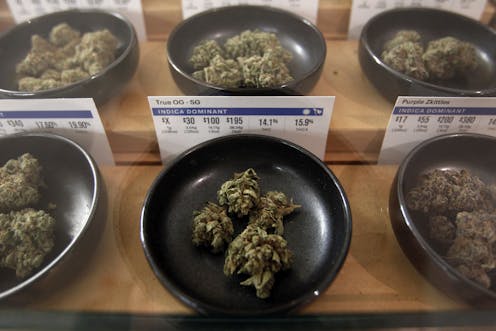Americans support legal marijuana – but states don't agree on how to regulate it
Medical marijuana? Recreational marijuana? Both or neither? Here's a quick guide to the topsy-turvy landscape for marijuana regulation in the US.

On 4/20, many across the U.S. gather to celebrate their love and appreciation for marijuana.
Polls show that 64 percent of Americans favor legalizing marijuana. But, despite the majority support, there’s no clear consensus on how it should be regulated. As a researcher who has studied the impact of drugs in the U.S. and Mexico, it’s been captivating to watch states adapt as they attempt to regulate this illicit and stigmatized substance.
Many states permit medical marijuana, but there’s a wide variety of approaches. Today, 29 states currently permit medical marijuana and have an established system for regulating it.
Another 17 states have limited medical programs. These programs provide access to products with low levels of tetrahydrocannabinol (THC) and high levels of cannabidiol (CBD), with the goal of eliminating the “high” and maximizing medical benefits. Beyond that, the conditions doctors and patients can treat with cannabis vary from state to state.
Minnesota, New York and West Virginia don’t permit marijuana smoking as part of their medical programs. West Virginia, however, allows patients to vaporize marijuana plant matter, while Minnesota only permits consumption of marijuana in liquid extract form.
Colorado, where I am based, has a much more expansive medical program. Patients can access an array of products, from extracts to strains of raw plant material. While New York caps the amount of THC that a product dose may contain, Colorado and other states have no such limit on their medical marijuana products.
Meanwhile, recreational marijuana use has been approved for adults 21 and over by nine states: Alaska, California, Colorado, Maine, Massachusetts, Nevada, Oregon, Vermont and Washington, as well as the District of Columbia.
However, once again, states haven’t implemented their policies uniformly. Vermont, for example, does not currently have a system for commercial sale and distribution, and only allows individuals to cultivate two plants. Colorado, on the other hand, has developed a robust commercial system, allows individuals to grow up to six plants, and limits the amount of marijuana products an individual can possess.
Most states have struggled with how to navigate the public consumption of cannabis, which remains illegal. As states continue to debate and implement marijuana policies, the American public will begin to recognize what works (and what doesn’t).
While these policy inconsistencies may raise concerns for some constituents, these state experiments are a valuable way to figure out how this substance works and how it affects society.
Santiago Guerra is affiliated with Colorado Springs Medical Marijuana Working Group as a content expert.
Read These Next
RFK Jr. wants to scrutinize the vaccine schedule – but its safety record is already decades long
Federal officials are questioning the safety of the vaccine series children receive. Here’s the story…
Deception and lies from the White House to justify a war in Venezuela? We’ve seen this movie before
Two US wars based on lies, in which tens of thousands of American troops and millions of civilians died,…
Miami’s new mayor faces a housing affordability crisis, city charter reform and a shrinking budget
Eileen Higgins won a hard-fought election to become Miami’s new mayor. Now for the hard part – governing…






